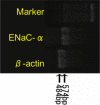The effect of topical amiloride eye drops on tear quantity in rabbits
- PMID: 21139975
- PMCID: PMC2994740
The effect of topical amiloride eye drops on tear quantity in rabbits
Abstract
Purpose: To investigate the presence of epithelial sodium channels (ENaC) in rabbit and human conjunctival epithelium and to test the effects of topical amiloride, a potassium-sparing diuretic that blocks the ENaC, on tear quantity in rabbits.
Methods: Both healthy normal human and rabbit conjunctival tissues underwent immunohistochemistry staining for ENaC-α and γ subunits as well as for reverse transcription-polymerase chain reaction (RT-PCR) for detection of ENaC-α and ENaC-γ subunit mRNA expression. Rabbits were instilled topical amiloride eye drops and tear function tests were performed before and after instillations.
Results: Immunohistochemical staining for ENaC-α subunit in all rabbit eyes showed positive staining in apical and basal conjunctival epithelial cells. Human conjunctival epithelia revealed positive staining with ENaC-α antibody especially in the apical and basal layers. Immunohistochemistry staining with ENaC- γ antibody also revealed positive staining of the conjunctival epithelial cells especially in the basal layers. The ENaC-α mRNA was detected in samples from healthy white rabbit conjunctival epithelia, and ENaC-α and ENaC- γ mRNAs were detected in samples from healthy human conjunctival epithelia. The mean tear quantity showed a significant increase at 15 and 30 min compared to the pre-instillation value in eyes assigned to amiloride eye drops. The mean tear quantity at 15 and 30 min was significantly higher in the amiloride group compared to the control eyes.
Conclusions: Topical amiloride application appears to increase the quantity of preocular tears owing to inhibition of conjunctival epithelial sodium channels.
Figures





Similar articles
-
Effect of topically applied epithelial sodium channel inhibitors on tear production in normal mice and in mice with induced aqueous tear deficiency.J Ocul Pharmacol Ther. 2012 Aug;28(4):433-8. doi: 10.1089/jop.2011.0157. Epub 2012 Mar 28. J Ocul Pharmacol Ther. 2012. PMID: 22455658 Free PMC article.
-
The effects of 3% diquafosol sodium application on the tear functions and ocular surface of the Cu,Zn-superoxide dismutase-1 (Sod1)-knockout mice.Mol Vis. 2014 Jun 28;20:929-38. eCollection 2014. Mol Vis. 2014. PMID: 24991185 Free PMC article.
-
The Role of 2% Rebamipide Eye Drops Related to Conjunctival Differentiation in Superoxide Dismutase-1 (Sod1) Knockout Mice.Invest Ophthalmol Vis Sci. 2018 Mar 1;59(3):1675-1681. doi: 10.1167/iovs.17-23213. Invest Ophthalmol Vis Sci. 2018. PMID: 29625494
-
Is the Amiloride-Sensitive Na+ Channel in Taste Cells Really ENaC?Chem Senses. 2020 May 21;45(4):233-234. doi: 10.1093/chemse/bjaa011. Chem Senses. 2020. PMID: 32099995 Free PMC article. Review.
-
δ ENaC: a novel divergent amiloride-inhibitable sodium channel.Am J Physiol Lung Cell Mol Physiol. 2012 Dec 15;303(12):L1013-26. doi: 10.1152/ajplung.00206.2012. Epub 2012 Sep 14. Am J Physiol Lung Cell Mol Physiol. 2012. PMID: 22983350 Free PMC article. Review.
Cited by
-
Experimental Pharmacotherapy for Dry Eye Disease: A Review.J Exp Pharmacol. 2021 Mar 23;13:345-358. doi: 10.2147/JEP.S237487. eCollection 2021. J Exp Pharmacol. 2021. PMID: 33790661 Free PMC article. Review.
-
Evaluating the Functionality of Conjunctiva Using a Rabbit Dry Eye Model.J Ophthalmol. 2016;2016:3964642. doi: 10.1155/2016/3964642. Epub 2016 Mar 20. J Ophthalmol. 2016. PMID: 27088007 Free PMC article.
-
Pro-Secretory Activity and Pharmacology in Rabbits of an Aminophenyl-1,3,5-Triazine CFTR Activator for Dry Eye Disorders.Invest Ophthalmol Vis Sci. 2017 Sep 1;58(11):4506-4513. doi: 10.1167/iovs.17-22525. Invest Ophthalmol Vis Sci. 2017. PMID: 28873176 Free PMC article.
-
Principles of Ocular Pharmacology.Handb Exp Pharmacol. 2017;242:3-30. doi: 10.1007/164_2016_25. Handb Exp Pharmacol. 2017. PMID: 27730396 Free PMC article.
-
Regional differences in rat conjunctival ion transport activities.Am J Physiol Cell Physiol. 2012 Oct 1;303(7):C767-80. doi: 10.1152/ajpcell.00195.2012. Epub 2012 Jul 18. Am J Physiol Cell Physiol. 2012. PMID: 22814399 Free PMC article.
References
-
- Garty H, Palmer LG. Epithelial sodium channels: function, structure, and regulation. Physiol Rev. 1997;77:359–96. - PubMed
-
- Kuang K, Cragoe EJ, Jr, Fischbarg J. Na+ channel blockers markedly decrease fluid pumping across corneal endothelium. Invest Ophthalmol Vis Sci. 1991;32:977.
-
- Stahl F, Lepple-Wienhues A, Koch M, Wiederholt M. Na(+)-dependent HCO3- transport and Na+/H+ exchange regulate pHi in human ciliary muscle cells. J Membr Biol. 1992;127:215–25. - PubMed
-
- Lin H, Kenyon E, Miller SS. Na-dependent pHi regulatory mechanisms in native human retinal pigment epithelium. Invest Ophthalmol Vis Sci. 1992;33:3528–38. - PubMed
-
- Swan JS, Hodson SA. Rabbit corneal hydration and the bicarbonate pump. J Membr Biol. 2004;201:33–40. - PubMed
MeSH terms
Substances
LinkOut - more resources
Full Text Sources
Other Literature Sources
Medical
